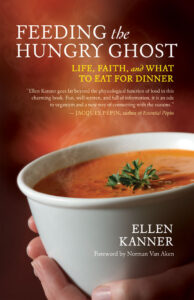What do we turn to for both everyday sustenance and seasonal celebration? Food. Ellen Kanner explains how we can impact our spiritual lives as well as our community through what we choose to put in our bodies. In Feeding the Hungry Ghost(New World Library, 2013), she describes the disconnect between us and our food, and the best way around that is giving our bodies the nutrition we need through a vegan lifestyle. The following excerpt comes from Chapter 1, “The Seed,” and talks
about the new beginnings that seeds provide both physically and metaphorically.
The Seed
Seeds
are where it all begins. They promise the start of things. They’re super-concentrated
sources of energy. I look at everything growing in my backyard, from my newly
sprouted purslane to the ten-foot firebush exploding with firecracker-red
flowers, favorite of zebra long-wing butterflies and hummingbirds, to our
thirty-foot live oak, which stretches its lanky, leafy limbs out to provide
shelter and canopy. They all began as seeds — everyday magic.
Nature makes that kind
of magic easy. You drop a seed in the dirt, cover it with soil, give it some
water, leave the sun and the seed to make friends with each other, and honey,
you’re in business.
But
then there’s the fine print. Firebush needs direct sun and can handle shallow,
sandy South Florida soil. It’s a tough native.
Purslane is supposed to be a weed and thus thrive like a weed, but mine’s
anemic, timid, probably suffering from sunstroke. Even weeds have their needs,
and purslane prefers filtered sunlight. A seed only fulfills its superhero
potential if it gets proper nurturing.
Then there are your more
metaphoric seeds (and I do love a metaphor), the new beginnings life offers you
— the joy of a new job, a new love, a new home, a new baby, a new year. Such
new beginnings endow you with all the energy of a seed. You’re awakening,
feeling your way, tentatively reaching your roots into the soil. These kinds of
seeds are times of hope; but they’re always times of change, and change is
tough.
Here’s what’s even
tougher — you don’t always get to choose a new beginning. Losing your job or
breaking up with your partner wouldn’t make anyone’s list of top ten fave life
events, but suddenly, there you are, in it up to your adenoids. That seed
generates an energy of its own — like a tornado, it rips up your life and
knocks you on your ass. It takes a herculean effort to roll out of bed in the
morning. Where’s the joy in that, ace?
And while it seems to be
raining seeds around you, both the happy kind and the seeds you wouldn’t even
wish on your ex, think of yourself as a seed, too — a really gorgeous,
spectacular, one-of-a-kind seed. But your gorgeousness can’t come into full
flowering unless you, too, get the nurturing you need.
For me, it means rooting
myself in my community, being part of the initiatives that bring real food and
real people together. Sometimes, I confess, I need to force myself to attend
this meeting, that event. But I’m almost always better for it. The people I meet
inspire me and energize me and take me in directions I didn’t know I wanted to
go. You’re growing oyster mushrooms? Wow, how do you do that? How can I do that? You’re teaching
children to cook? Can I volunteer? I’m lucky to be nourished by my native soil.
You know best what kind
of metaphoric soil you need, where you feel your happiest, truest self, where
your own strength is coaxed forth, where you can set down strong roots and lift
your face to the sun.
Or maybe you don’t know.
Maybe you’ve been so pelted with misery seeds, you barely know what you look
like, let alone what you need. They say suffering is wonderfully character
building. I say you’ve got plenty of character as it is. I say whatever’s
giving you grief should just get out of your way and get out of town. Until it
does, though, you’re stuck. You’re going through hell, it’s taking every ounce
of your strength, and you can’t quite see how you’re ever going to return to
that blissful, faraway place called normal.
What to Eat
Start by nurturing
yourself. A basic way to give yourself the care you need is to pay attention to
what you eat and to make healthier choices for all concerned — for you, for the
planet.
Seeds are an easy place
to begin. While vegetables still have their detractors (why? why?), anyone can chomp on a
handful of seeds. If you’re struggling, they’ll support you nutritionally and
offer a sprinkle of badly needed cheer. If you’re happy, they’ll only make you
happier. They offer a crunch that bespeaks indulgence, but with it come the
phytonutrients and fats our bodies hunger for, the kind that give us a nice
inner glow, no microdermabrasion required.
Some seeds we snarf —
sunflower seeds, pepitas (pumpkin seeds).
Some seeds we use to
impart deep flavor in cooking — cumin, cardamom, mustard, coriander, fennel, to
name a few of my favorites.
Some we eat without even
realizing what they are. All your legumes, from teensy red lentils to massive
gigantes are, botanically speaking, seeds.
And some we mean to get
around to trying, because we hear how tremendous they are for our health, yet
we’re daunted by them — flax, chia, and hemp come to mind.
Well,
honey, your time has come. Whether you’re flourishing or faltering, you need
more of these teensy guys in your life. Flax rules when it comes to omega-3s,
those excellent fatty acids. Chia seeds are right up there in the omega-3
department, but they also have a fantastic amount of fiber and antioxidants.
Ancient Aztec warriors thrived on them, and they were pretty tough guys. Hemp
seeds, tiniest of all, offer more protein per ounce than any animal protein.
Use them individually or
mixed together in a seedy cocktail as a topping for casseroles and roasted
vegetables. We love texture. Add them to grain dishes, both sweet and savory —
oatmeal isn’t oatmeal for me without a sprinkling of seeds. And chia and flax
make excellent egg substitutes in baking. Mixing the seeds with a little water
forms a bonding agent. Not only do you get the body-supporting benefit of the
seeds; you get the nice cohesive quality of eggs without the cholesterol and
without ruffling a single chicken feather.
Seed Cake
I believe in backing up talk with
something worth eating. So when I was thinking what kind of seedy recipe to use
here, I thought of cake–seed cake, simple but soulful and long beloved in England,
Ireland, and Scotland. Its origins date back as far as the Middle Ages, and
back in the day, the seed in question tended to be caraway, making for a treat
that walked the line between sweet and savory. Good as far as it goes, but
trending toward heavy, and certainly heavy in vegan-unfriendly ingredients like
butter, milk, and eggs.
Vegan baking, like life,
is about balance and compromise. Rather than weird you out with a bunch of
arcane ingredients you’ll have to shop for, I’ve swapped the traditional dairy
and eggs for other items that are whole and plant based and fairly gettable.
I’ve also swapped caraway seeds for anise. Like caraway, anise is excellent for
digestion but has a gentler flavor. It’s mildly licorice-y and is mellow in the
mouth. It joins a symphony of other seeds for a moist cake of haunting
fragrance and flavor.
Seed Cake Recipe
Serve as dessert or as
an anytime restorative with coffee or tea.
Serves 8 or so
- 1 cup unsweetened soy or hemp milk
- 2 tablespoons ground flaxseeds (also
known as flax meal) - 2 tablespoons ground chia seeds
- 2 teaspoons anise seeds
- 1 1/2 cups whole wheat flour
- 1 teaspoon baking soda
- 1 teaspoon aluminum-free baking powder
- Zest and juice of 1 lemon
- 3/4 cup evaporated cane sugar
- 1/3 cup hemp, flax, or canola oil, plus more
for the pan - 1/2 cup unsweetened applesauce
- 1/3 cup raisins
Preheat the oven to 350°F. Lightly oil an
8-inch round cake pan or a 9-x-5-inch loaf pan.
In a small bowl, combine the soy milk,
flaxseeds, chia seeds, and anise seeds. Stir gently to combine and let sit
while you assemble the other ingredients.
In a large bowl, sift together the whole
wheat flour, baking soda, and baking powder. Add the lemon zest.
In another large bowl, stir together the
evaporated cane sugar, hemp oil, applesauce, and lemon juice. Add to the flour
mixture, along with the soy milk mixture, which, thanks to the seeds, will have
thickened madly. Stir together, then fold in the raisins.
Pour into the prepared baking pan. Bake
for 45 minutes, or until the cake is golden and puffed, and a tester inserted
in the center comes away crumb-free and clean. You can also give it a gentle
poke with a finger; it should spring back when baked through.
Remove from the oven and let cool.
Wrapped well and refrigerated, the cake keeps for several days.
Reprinted with permission from Feeding the Hungry Ghost: Life, Faith and What to Eat for Dinner by
Ellen Kanner and published by New World Library, 2013.





